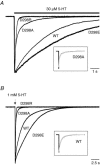Role of aspartate 298 in mouse 5-HT3A receptor gating and modulation by extracellular Ca2+
- PMID: 16096341
- PMCID: PMC1474733
- DOI: 10.1113/jphysiol.2005.092866
Role of aspartate 298 in mouse 5-HT3A receptor gating and modulation by extracellular Ca2+
Abstract
The TM2-TM3 extracellular loop is critical for activation of the Cys-loop family of ligand-gated ion channels. The contribution of aspartate 298 (D298), an amino acid that links the transmembrane domain 2 (TM2) to the TM2-TM3 loop, in mouse 5-hydroxytryptamine(3A) (5-HT(3A)) receptor function was probed with site-directed mutagenesis in the present study. This negatively charged residue was replaced with an alanine to neutralize the charge, with a glutamate to conserve the charge, or with an arginine to reverse the charge. Human embryonic kidney 293 (HEK 293) cells transfected with the wild-type and mutant receptors were studied by combining whole-cell patch-clamp recording with fast agonist application. The D-->A or D-->R mutations resulted in a receptor with reduced 5-HT potency, and accelerated kinetics of desensitization and deactivation. In addition, the efficacy of partial agonists was reduced by the D-->A mutation. The D-->E mutation produced a receptor with properties similar to those of the wild-type receptor. In addition, the potential role of this residue in modulation of the receptor by extracellular calcium ([Ca(2)(+)](o)) was investigated. Increasing [Ca(2)(+)](o) inhibited 5-HT-activated currents and altered receptor kinetics in a similar manner in the wild-type and D298E receptors, and this alteration was eliminated by the D-->A and D-->R mutations. Our data suggest that the charge at D298 participates in transitions between functional states of the 5-HT(3A) receptor, and provide evidence that the charge of the side-chain at residue D298 contributes to channel gating kinetics and is crucial for Ca(2)(+) modulation.
Figures








Similar articles
-
The L293 residue in transmembrane domain 2 of the 5-HT3A receptor is a molecular determinant of allosteric modulation by 5-hydroxyindole.Neuropharmacology. 2008 Jun;54(8):1153-65. doi: 10.1016/j.neuropharm.2008.03.009. Epub 2008 Mar 27. Neuropharmacology. 2008. PMID: 18436267 Free PMC article.
-
Arginine 222 in the pre-transmembrane domain 1 of 5-HT3A receptors links agonist binding to channel gating.J Biol Chem. 2003 Nov 21;278(47):46583-9. doi: 10.1074/jbc.M308974200. Epub 2003 Sep 11. J Biol Chem. 2003. PMID: 12970351
-
The 4'lysine in the putative channel lining domain affects desensitization but not the single-channel conductance of recombinant homomeric 5-HT3A receptors.J Physiol. 2000 Jan 15;522 Pt 2(Pt 2):187-98. doi: 10.1111/j.1469-7793.2000.00187.x. J Physiol. 2000. PMID: 10639097 Free PMC article.
-
Molecular determinants of single-channel conductance and ion selectivity in the Cys-loop family: insights from the 5-HT3 receptor.Trends Pharmacol Sci. 2005 Nov;26(11):587-94. doi: 10.1016/j.tips.2005.09.011. Epub 2005 Sep 27. Trends Pharmacol Sci. 2005. PMID: 16194573 Review.
-
Novel structural determinants of single channel conductance and ion selectivity in 5-hydroxytryptamine type 3 and nicotinic acetylcholine receptors.J Physiol. 2010 Feb 15;588(Pt 4):587-96. doi: 10.1113/jphysiol.2009.183137. Epub 2009 Nov 23. J Physiol. 2010. PMID: 19933751 Free PMC article. Review.
Cited by
-
Psychotropic and nonpsychotropic cannabis derivatives inhibit human 5-HT(3A) receptors through a receptor desensitization-dependent mechanism.Neuroscience. 2011 Jun 16;184:28-37. doi: 10.1016/j.neuroscience.2011.03.066. Epub 2011 Apr 6. Neuroscience. 2011. PMID: 21477640 Free PMC article.
-
Inhibition of the prokaryotic pentameric ligand-gated ion channel ELIC by divalent cations.PLoS Biol. 2012;10(11):e1001429. doi: 10.1371/journal.pbio.1001429. Epub 2012 Nov 20. PLoS Biol. 2012. PMID: 23185134 Free PMC article.
-
The L293 residue in transmembrane domain 2 of the 5-HT3A receptor is a molecular determinant of allosteric modulation by 5-hydroxyindole.Neuropharmacology. 2008 Jun;54(8):1153-65. doi: 10.1016/j.neuropharm.2008.03.009. Epub 2008 Mar 27. Neuropharmacology. 2008. PMID: 18436267 Free PMC article.
-
Structural determinants of Ca2+ permeability and conduction in the human 5-hydroxytryptamine type 3A receptor.J Biol Chem. 2008 Jul 11;283(28):19301-13. doi: 10.1074/jbc.M802406200. Epub 2008 May 12. J Biol Chem. 2008. PMID: 18474595 Free PMC article.
-
Asymmetric opening of the homopentameric 5-HT3A serotonin receptor in lipid bilayers.Nat Commun. 2021 Feb 16;12(1):1074. doi: 10.1038/s41467-021-21016-7. Nat Commun. 2021. PMID: 33594077 Free PMC article.
References
-
- Absalom NL, Lewis TM, Kaplan W, Pierce KD, Schofield PR. Role of charged residues in coupling ligand binding and channel activation in the extracellular domain of the glycine receptor. J Biol Chem. 2003;278:50151–50157. - PubMed
-
- Bera AK, Chatav M, Akabas MH. GABAA receptor M2–M3 loop secondary structure and changes in accessibility during channel gating. J Biol Chem. 2002;277:43002–43010. - PubMed
-
- Bouzat C, Gumilar F, Spitzmaul G, Wang HL, Rayes D, Hansen SB, Taylor P, Sine SM. Coupling of agonist binding to channel gating in an ACh-binding protein linked to an ion channel. Nature. 2004;430:896–900. - PubMed
Publication types
MeSH terms
Substances
LinkOut - more resources
Full Text Sources
Molecular Biology Databases
Miscellaneous

